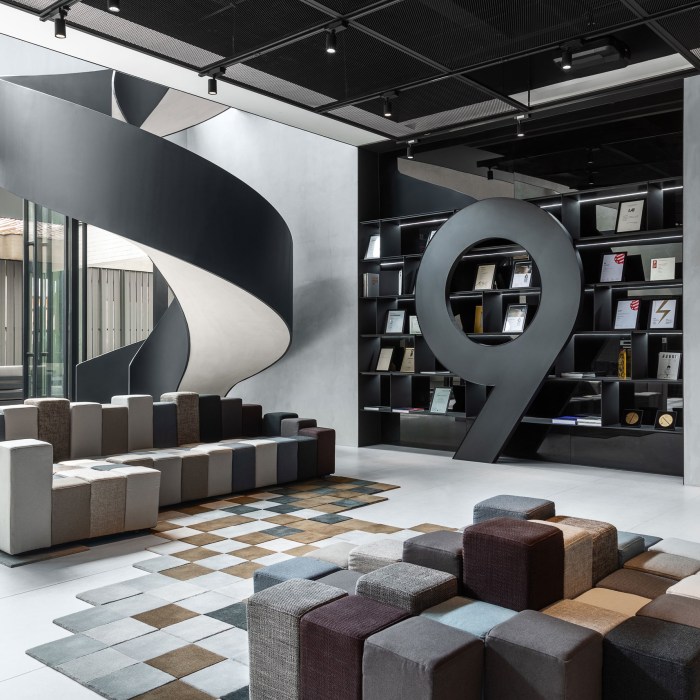Dive into the realm of interior architecture, where design meets functionality and aesthetics blend seamlessly. Discover the intricate relationship between interior design and architecture, and how it shapes the spaces we inhabit.
Unveil the key elements, spatial planning techniques, and sustainable practices that define the essence of interior architecture.
What is Interior Architecture?
Interior architecture is a specialized field that focuses on the design and optimization of interior spaces within buildings. It involves creating functional and aesthetically pleasing environments that enhance the quality of life for occupants.
Relationship Between Interior Design and Architecture
Interior architecture and interior design are closely related disciplines, but they have distinct differences. While interior design primarily deals with the aesthetics, furnishings, and decorative elements of a space, interior architecture goes beyond that by considering the structural and spatial aspects of the interior environment.
Interior architects work in collaboration with architects to ensure that the interior spaces are not only visually appealing but also functional and safe.
Influence on Functionality of a Space
Interior architecture plays a crucial role in determining the functionality of a space. By carefully planning the layout, circulation, and organization of interior elements, interior architects can optimize the use of space and improve the overall user experience. Factors such as lighting, acoustics, materials, and furniture selection are all taken into consideration to create spaces that are efficient, comfortable, and conducive to their intended use.
Elements of Interior Architecture

Interior architecture involves various key elements that are essential in creating functional and aesthetically pleasing spaces. These elements work together to design interiors that meet the needs and preferences of the occupants.
Lighting Design
Lighting design is a crucial element in interior architecture as it can completely transform the look and feel of a space. Proper lighting enhances the atmosphere, highlights architectural features, and influences the overall mood. It involves the strategic placement of different types of lighting such as ambient, task, and accent lighting to create a well-balanced and visually appealing environment.
Materials and Finishes
The choice of materials and finishes in interior architecture plays a significant role in determining the style, durability, and functionality of a space. Different materials such as wood, glass, metal, and fabrics can be used to create textures, patterns, and visual interest.
The selection of finishes like paint, wallpaper, flooring, and upholstery can add depth and character to the design. It is important to consider factors such as maintenance, cost, sustainability, and aesthetics when choosing materials and finishes for interior spaces.
Spatial Planning in Interior Architecture
Spatial planning in interior architecture involves strategically organizing and arranging interior spaces to optimize functionality, efficiency, and aesthetics. This process considers the flow of movement within a space, known as traffic flow, and incorporates ergonomic principles to enhance user experience.
Traffic Flow Considerations
- Interior architects carefully plan the layout of furniture, fixtures, and circulation paths to ensure a smooth and intuitive flow of movement within a space.
- Factors such as the location of doors, windows, and focal points are taken into account to create natural pathways that guide occupants through the space.
- By analyzing how people move through a space, designers can minimize congestion, optimize usage of space, and enhance overall user experience.
Importance of Ergonomics
- Ergonomics plays a crucial role in interior architecture design as it focuses on creating spaces that are comfortable, safe, and efficient for occupants to use.
- Designers consider human factors such as posture, reach, and movement patterns to ensure that furniture and fixtures are ergonomically designed for optimal functionality and user comfort.
- By incorporating ergonomic principles, interior architects can improve productivity, reduce the risk of injuries, and enhance the overall well-being of individuals using the space.
Sustainable Practices in Interior Architecture
Sustainable design principles play a crucial role in interior architecture, aiming to minimize the negative impact on the environment while creating functional and aesthetically pleasing spaces. The use of eco-friendly materials and sustainable practices has become increasingly important in modern interior design projects, influencing everything from material selection to energy efficiency.
Use of Eco-Friendly Materials
When it comes to interior architecture, the choice of materials can significantly impact the sustainability of a project. Designers are now opting for eco-friendly materials such as reclaimed wood, bamboo, cork, and recycled glass to reduce the environmental footprint of their designs.
These materials not only help in conserving natural resources but also promote a healthier indoor environment for occupants.
Impact of Sustainable Practices
Sustainable practices in interior architecture have a profound impact on the overall design process. By incorporating energy-efficient lighting, proper insulation, and passive design strategies, designers can create spaces that are not only visually appealing but also reduce energy consumption and waste.
Sustainable practices also extend to furniture selection, where designers prioritize pieces made from sustainable materials and produced through ethical manufacturing processes.
Conclusion
In conclusion, interior architecture is a dynamic field that harmoniously combines artistry and functionality to create spaces that inspire and uplift. Delve into this captivating world and unlock the secrets of design excellence.
FAQ Compilation
What is the concept of interior architecture?
Interior architecture focuses on the design and functionality of interior spaces, incorporating elements of both architecture and design to create harmonious environments.
How does lighting design impact interior architecture?
Lighting design plays a crucial role in enhancing the ambiance and functionality of a space in interior architecture by highlighting architectural features and creating moods.
Why is spatial planning important in interior architecture?
Spatial planning ensures efficient use of space, optimal traffic flow, and the creation of user-friendly environments in interior architecture projects.
What are sustainable design principles in interior architecture?
Sustainable design in interior architecture focuses on using eco-friendly materials, energy-efficient solutions, and reducing environmental impact throughout the design process.
How does interior architecture influence the functionality of a space?
Interior architecture considers the layout, flow, and usability of a space to enhance its functionality and create environments that cater to the needs of inhabitants.










